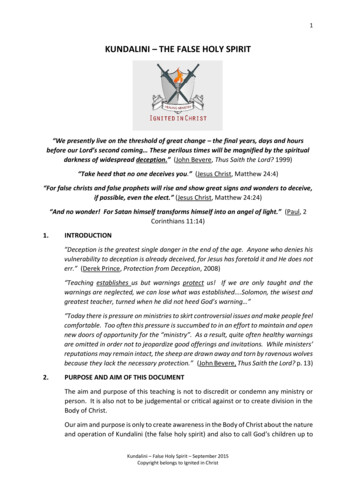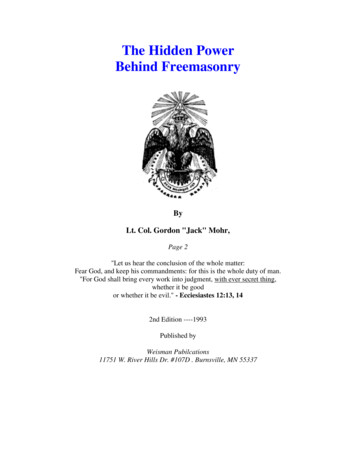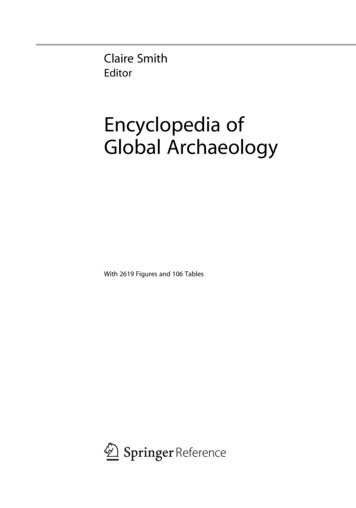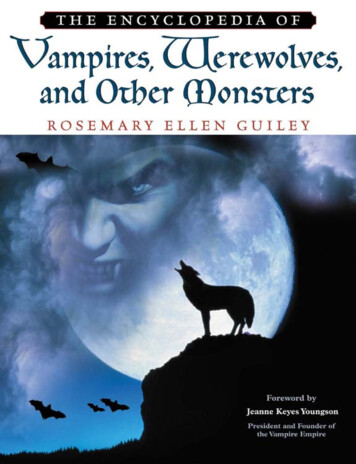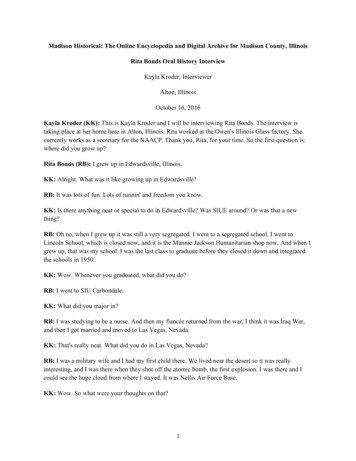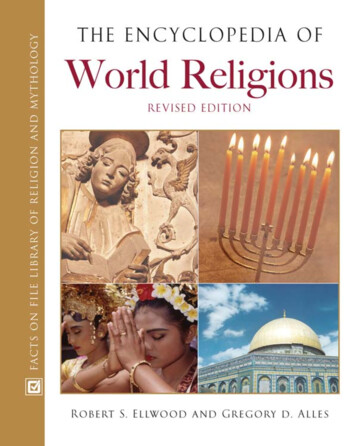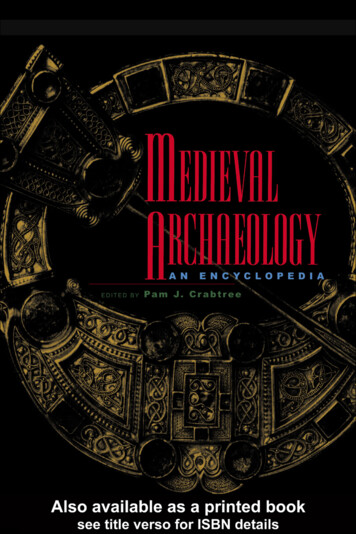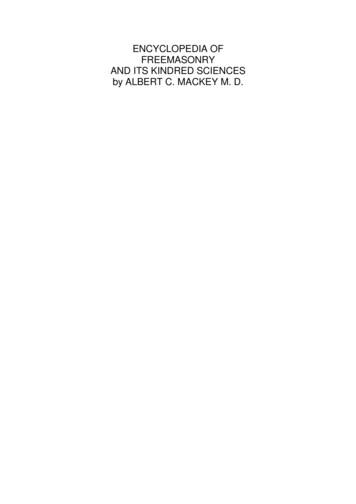
Transcription
ENCYCLOPEDIA OFFREEMASONRYAND ITS KINDRED SCIENCESby ALBERT C. MACKEY M. D.
PREFACEI ONCE delivered an address before a Lodge on the subject of the external changes whichFreemasonry had undergone since the period of its revival in the commencement of theeighth century.The proper treatment of the topic required a reference to German, to French, and to Englishauthorities, with some of which I am afraid that many of my auditors were not familiar. At theclose of the address, a young and intelligent Brother inquired of me how he could obtainaccess to the works which I had cited, and of many of which he confessed, as well as of thefacts that they detailed, he now heard for the first time. It is probable that my reply was notaltogether satisfactory for I told him that I knew of no course that he could adopt to attain thatknowledge except the one that had been pursued by myself, namely, to spend his means inthe purchase of Masonic books and his time in reading them.But there are few men who have the means, the time, and the inclination for the purchase ofnumerous books, some of them costly and difficult to be obtained, and for the close andattentive reading of them which is necessary to master any given subject. It was this thoughtthat, years ago, suggested to me the task of collecting materials for a work which wouldfurnish every Freemason who might consult its pages the means of acquiring a knowledge ofall matters connected with the science, the philosophy, and the history of his Order.But I was also led to the prosecution of this work by a higher consideration. I had myselflearned, from the experience of my early Masonic life, that the character of the Institution waselevated in every one's opinion just in proportion to the amount of knowledge that he hadacquired of its symbolism, philosophy, and history. If Freemasonry was not at one timepatronized by the learned, it was because the depths of its symbolic science and philosophyhad not been sounded. If it is now becoming elevated and popular in the estimation ofscholars, it owes that elevation and that popularity to the labors of those who have studied itsintellectual system and given the result of their studies to the world. The scholar will rise fromthe perusal of Webb's Monitor, or the Hieroglyphic Chart of Cross, with no very exaltedappreciation of the literary character of the Institution of which such works profess to be anexponent. But should he have met with even Hutchinson's spirit of Masonry, or Town'sspeculative Masonry, which are among the earlier products of Masonic literature, he will beconscious that the system which could afford material for such works must be worthy ofinvestigation. Oliver is not alone in the belief that the higher elevation of the Order is to beattributed almost solely to the judicious publications on the subject of Freemasonry whichhave appeared during the present (nineteenth) and the end of the last (eighteenth) century. Itis the press that is elevating the Order ; it is the labor of its scholars that is placing it in therank of sciences. The more that is published by scholarly pens on its principles, the more willother scholars be attracted to its investigation. At no time, indeed, has its intellectualcharacter been more justly appreciated than at the present day. At no time have its membersgenerally cultivated its science with more assiduity. At no time have they been more zealousin the endeavor to obtain a due enlightenment on all the topics which its systemcomprehends.It was the desire to give my contribution toward the elevation of the Order, by aiding in thedissemination of some of that light and knowledge which are not so easy of access, thatimpelled me years ago to commence the preparation of this work, a task which I have steadilytoiled to accomplish, and at which, for several years, I have wrought with un-intermitted laborthat has permitted but little time for other occupation, and none for recreation. And now Ipresent to my Brethren the result not only of those years of toil, but of more than thirty yearsof study and research-a work which will, I trust, or at least I hope, supply them with thematerials for acquiring a knowledge of much that is required to make a Masonic scholar.Encyclopedia learning is not usually considered as more than elementary. But knowing thatbut few Freemasons can afford time to become learned scholars in our art by an entiredevotion to its study, I have in important articles endeavored to treat the subject exhaustively,
and in all to give that amount oi information that must make future ignorance altogether theresult of disinclination to learn.I do not present this work as perfect, for I well know that the emanating point of perfection cannever be attained by human effort.But, under many adverse circumstances, I have sought to make it as perfect as I could.Encyclopedias are, for the most part, the result of the conjoined labor of many writers. In thiswork I have had no help. Every article was written by myself. I say this not to excuse myerrors for I hold that no author should wilfully permit an error to pollute his pages, but rather toaccount for those that may exist. I have endeavored to commit none.Doubtless there are some. If I knew them, I would correct them, but let him who discoversthem remember that they have been unwittingly committed in the course of an exhaustive andunaided task.For twelve months, too, of the time in which I have been occupied upon this work, I sufferedfrom an affection of the sight, which forbade all use of the eyes for purposes of study. Duringthat period, now happily passed, all authorities were consulted under my direction by thewilling eyes of my daughters, all writing was done under my dictation by their hands. I realizedfor a time the picture so often painted of the blind bard, John Milton, dictating his sublimeverses to his daughters. It was a time of sorrow for the student who could not labor with hisown organs in his vocation ; but it was a time of gladness to the father who felt that he hadthose who, with willing hearts, could come to his assistance. To the world this is of no import ;but I could not conscientiously close this prefatory address without referring to thiscircumstance so gratifying to a parent's heart. Were I to dedicate this work at all, mydedication should be, To FILIAL AFFECTION.ALBERT G. MACKEY
MACKEY'SFREEMASONRY ENCYCLOPEDIAA-1AIn the Accadian, Greek, Etruscan, Pelasgian, Gallic, Samaritan, and Egyptian or Coptic, ofnearly the same formation as the English letter. It originally meant with or together, but atpresent signifies one. In most languages it is the initial letter of the alphabet not so, however,in the Ethiopian, where it is the thirteenth. This familiar first letter of the alphabet comes downto our own modern times from the most remote period recorded of the world's history. Thecommon form of the letter corresponds closely to that in use by the Phoenicians at least tencenturies before the Christian Era, as in fact it does to almost all its descendants. Men of Tyrewere Phoenicians, and we may trace the sound of the name they gave this letter by noting thepronunciation of the first letters in the alphabets of the Hebrews and the Grieks who tookthem from the same source. We derive the word alphabet from the first two Greek letters, andthese are akin in their names to the Hebrew Aleph, or Awlef, and Bayth. Sounds of theseletters, as in English words, must not be confused with the pronunciation of the names forthem. The name of the Hebrew Aleph, signifies ox from the resemblance of the letter to thehead and horns of that animal.The sacred Aleph has the numerical value of one and is made up of two Yodes, one on eachside of an inclined bar or Vawv. This combination of characters is said to typify the Trinity inUnity. The Divine name in Hebrew connected with this letter is, A H I H.*A. A. O. N. M. S.These letters are the initials of the words Ancient Arabic Order Noblea Mystia Shrine (seeshrine). They may be rearranged to spell out the words A Mason. The claim has been made
in all sincerity that this peculiarity was prearranged and is not at all accidental. Such aprobability is not as rare as in type as may at first be imagined.For instance the York Roll No. 1, about 1600 A.D., starts out quaintly with such an endeavorin the form of an anagram, the letters of words or phrases transposed to make different wordsor phrases, thus:An Anagraimee upon the name of MasonrieWilliam Kay to his friend Robert Prestonupon his Art of Masonrie as Followeth :Much might be said of the O noble ArttA Craft that'a worth estieming in each partSundry Nations Noobles & their Kings alsoOh how they fought its worth to knowNimrod & Solomon the wisest of all menReason saw to love this Science thenIle say noe more lest by my shallow verses IEndeavoring to praise should blemish Masonrie.*AARONHebrew, A-har-ohne, a word of doubtful etymology, but generally supposed to signify amountaineer. Mackenzie says the name means the illuminated. He was the brother of Moses,and the first High Priest under the Mosaic dispensation, whence the priesthood established bythat lawgiver is known as the Masonic. He is mentioned in the English lectures of the SecondDegree, in reference to a certain sign which is said to have taken its origin from the fact thatAaron and Hur were present on the hill from which Moses surveyed the battle which Joshuawas waging with the Amalekites, when these two supported the weary arms of Moses in anupright posture, because upon his uplifted hands the fate of the battle depended (see Exodusxvii, 10-12). Aaron is also referred to in the latter section of the Royal Arch Degree inconnection with the memorials that were deposited in the Ark of the Covenant. In the Degreeor Grade of Chief of the Tabernacle, which is the Twenty-third of the Ancient and AcceptedScottish Rite, the presiding officer represents Aaron, and is styled Most Excellent High Priest.In the Twenty-fourth Degree of the same Rite, or Prince of the Tabernacle, the second officeror Senior Warden also personates Aaron.*AARON'S BANDA Degree instituted in 1824, in New York City, mainly for social purposes, and conferred in anindependent body. Its ceremonies were similar to those of the Order of High Priesthood,which caused the Grand Royal Arch Chapter of the State to take offence, and the smallgathering dispersed in 1825.*AARON'S RODThe method by which Moses caused a miraculous judgment as to which tribe should beinvested with the priesthood, is detailed in the Book of Numbers (chapter xvii). He directedthat twelve rods should be laid up in the Holy of Holies of the Tabernacle, one for each tribe;that of Aaron, of course, represented the tribe of Levi. On the next day these rods werebrought out and exhibited to the people, and while all the rest remained dry and withered, thatof Aaron alone budded and blossomed and yielded fruit. There is no mention in thePentateuch of this rod having been placed in the ark, but only that it was put before it. But as
Saint Paul, or the author of the Epistle to the Hebrews (Hebrews ix, 4), asserts that the rodand the pot of manna were both within the ark, Royal Arch Masons have followed this laterauthority. Hence the rod of Aaron is found in the ark; but its import is only historical, as if toidentify the substitute ark as a true copy of the original, which had been lost. No symbolicalinstruction accompanies its discovery.*AB1. The 11th month of the Hebrew civil year and corresponding to the months July andAugustus, beginning with the new moon of the former.2. It is also a Hebrew word, signifying father, and will be readily recognized by everyFreemason as a component part of the name Hiram Abif, which literally means Hiram hisfather (see Abif).*ABACISCUSThe diminutive of Abacus- and, in architecture, refers to the squares of the tessellatedpavement or checkered surface of the ground floor of King Solomon's Temple.*ABACUSA term which has been erroneously used to designate the official staff of the Grand Master ofthe Templars. The word has no such meaning ; for an abacus is either a table used forfacilitating arithmetical calculations, or is in architecture the crowning plate of a column and itscapital. The Grand Master's staff was a baculus, which see.*ABADDONA Hebrew word ab-ad-done, signifying destruction. By the Rabbis it is interpreted as the placeof destruction, and is the second of the seven names given by them to the region of the dead.In the Apocalypse (Revelation ix, 11) it is rendered by the Greek word Apollyon, and meansthe destroyer. In this sense it is used as a significant word in the high degrees.*ABAZARProbably from the Hebrew word ab-ee-ay-zer, meaning helpful. The title given to the Masterof Ceremonies in the Sixth Degree of the Modern French Rite.*ABBREVIATIONSAbbreviations of technical terms or of official titles are of very extensive use in Freemasonry.They were, however, but rarely employed in the earlier Masonic publications. For instance,not one is to be found in the first edition of Anderson's Constitutions. Within a comparatively
recent period they have greatly increased, especially among French writers, and a familiaritywith them is therefore essentially necessary to the Masonic student.Frequently, among English and always among French authors, a Masonic abbreviation isdistinguished by three points,.:, in a triangular form following the letter, which peculiar markwas first used, according to Ragon, on the 12th of August, 1774, by the Grand Orient ofFrance, in an address to its subordinates. No authoritative explanation of the meaning ofthese points has been given, but they may be supposed to refer to the three lights around thealtar, or perhaps more generally to the number three, and to the triangle, both importantsymbols in the Masonic system.A representative list of abbreviations is given, and these will serve as a guide to the commonpractice, but the tendency to use such conveniences is limited only by personal tastegoverned by the familiarity of the Brethren using them with one another. This acquaintancemay permit the mutual use of abbreviations little known elsewhere. All that can be done is tooffer such examples as will be helpful in explaining the usual custom and to suggest themanner in which the abbreviations are employed. With this knowledge a Freemason canascertain the meaning of other abbreviations he may find in his Masonic reading.Before proceeding to give a list of the principal abbreviations, it may be observed that thedoubling of a letter is intended to express the plural of that word of which the single letter isthe abbreviation.Thus, in French, F.:, signifies Frére, or Brother, and FF :. Fréres, or Brothers. And in English,L :. is sometimes used to denote Lodge, and LL :, to denote Lodges. This remark is madeonce for all, because we have not deemed it necessary to augment the size of the list ofabbreviations by inserting these plurals. If the reader finds S:.G:.I:. to signify Sovereign GrandInspector, he will be at no loss to know that SS:.GG:.II:. must denote Sovereign GrandInspectors. A:.&A:. Ancient and Accepted.A:.&A:. R :. Ancient and Accepted Rite as used in England.A:.&A:. S :. R :. Ancient and Accepted Scottish Rite.A:.&P:. R :. Ancient and Primitive Rite.A:.C:. Anno Coadio. Latin, meaning the Year of Destruction; referring to the year 1314 inKnights Templar history.A:.D:. Anno Domini. Latin, meaning Year of Our Lord.A:.Dep:. Anno Depositionis. Latin, meaning In the Year of the Deposit. The date is used byRoyal and Select Masters.A:.F:.M:. Ancient Freemasons.A:.F:.&A:.M :. Ancient Free and Accepted Masons.A:.H:. Anno Hebraico. Latin, meaning Hebrew Year.A:.Inv:. Anno Inventionis. Latin, meaning In the Year of the Discovery. The date used byRoyal Arch Masons.A:.L:. Anno Lucis. Latin, meaning In the Year of Light. The date used by Ancient CraftFreemasons.A.:L:.G:.D:.G:.A:.D:.L:.U:. A la Gloire du Grand Architecte de l'Universe. French, meaning Tothe Glory of the Grand Architect of the Universe. The usual caption of French Masonicdocuments.A:.L:. O:. A L Orient. French, meaning At the East. The Location or seat of the Lodge.A.:M:.Anno Mundi. Latin, meaning In the Year of the World. The date used in the Ancient andAccepted Rite.A.:O:. Anno Ordinis. Latin, meaning In the Year of the 0rder. The date used by KnightsTemplar.A.:Q.:C:. Ars Quatuor Coronatorum, the Latin name for the printed reports of the QuatuorCoronati Lodge, No. 2076, London.A.:V.:L:. An du Vraie Lumiére. French, meaning Year of the True Light.A.:V:.T:.O:.S.:A.:G:. Ad Universi Terrarum Orbis Summi Architecti Gloriam. Latin, meaning Tothe glory of the Grand Architect of the Universe.A.:Y.:M:. Ancient York Masons or Ancient York Masonry.
B.: Bruder. German, meaning Brother.B.:A.: Buisson Ardent. French, meaning Burning Bush.B:.B:. Burning Bush.Bn:. Brudern. German, meaning Brethren.Comp.: Companion. Used by Brethren of the Royal Arch.C:.C:. Celestial Canopy.C:.H:. Captain of the Host.D:. Deputy.D:.A:.F:. Due and Ancient Form.D:.D:.G:.M:. Sometimes abbreviated Dis :.D:.G:.M:. District Deputy Grand Master.D:.G:.B:.A:.W:. Der Grosse Baumeister aller Welten. German, meaning The. Grand Architectof all Worlds.D:.G:.G:.H:.P:. Deputy General Grand High Priest.D:.G:.H:.P:. Deputy Grand High Priest.D:.G:.M:. Deputy Grand Master.D:.M:.J:. Deus Meumque Jus. Latin, meaning God and my right.D:.Prov:.G:.M:. Deputy Provincial Grand Master.Deg:. Degree or Degrees. Another way is as in 33 ,meaning Thirty-Third Degree.Dis:. District.E:.Eminent; Excellent; also East.E:.A:. Entered Apprentice. Sometimes abbreviated E:.A:.P:.E:.C:. Excellent Companion.Ec:. Ecossaise. French, meaning Scottish; belonging to the Scottish Rite.E:.G:.C:. Eminent Grand Commander.E:.G:.M:. Early Grand Master. A central Authority had been made to control the KnightsTemplar of Ireland independently of the Grand Lodge and at the very first meeting of theLodge "at High Noon of St. John." 1779, the Worshipful Master appended to his name theletters E. G. M.,that is, Early Grand Master. There was then no governing body inFreemasonry except the Grand Lodge (see "Templar Legends," by Brother W. J.ChetwodeCrawley, Transactions, Quatuor Coronati Lodge, 1913, volume xxvi).E:.O:.L:. Ex Oriente Lux. Latin, meaning Out of the East comes Light. E:.V:. Era Vulgus. Latin,meaning Common Era, also stands for Ere Vulgaire, French, meaning Vulgar Era; Year of theLord.F:. Frére. French, meaning Brother.F:.A:.M:. Free and Accepted Masons.F:.E:.R:.T:. According to the statutes of the United Orders of the Temple &nd Saint John ofJerusalem, etc., the standard of Saint John is described as gules, on a Cross Argent, theAgnus Dei-meaning Red on a Silver Cross with a representation of the Lamb of God-with theletters F.E.R.T. These letters are the initials of the words of the motto Fortitudine EjusRhodum tenuit, meaning By his courage he held Rhodes. Brother Gordon P. G. Hills,Transactions of Quatuor Coronati Lodge, 1914, volume xxvii page 233, says, "I suppose itrefers to the gallant defense by the Grand Master in 1522, when however, the Island wassurrendered, although the garrison were permitted to depart with the honors of war." A writerin the Pall Mall Gazette, June 4, 1901, states that the legend appears on the coinage of Louisof Savoy in 1301 and on that of Thomas in 1233.F:.C:. Fellow Craft.F:.M:. Freemason.G:.Grand- Sometimes read as Great; Geometry. Also has another meaning well known to theCraft.G:.A:.O.:T:.U:. Grand Architect of the Universe.G:.A:.S:. Grand Annual Sojourn.G.:C:. Grand Chapter; Grand Council; Grand Cross; Grand Commander; Grand Chaplain;Grand Conclave; Grand Conductor; Grand Chancellor.G:.C:.G:. Grand Captain General; Grand Captain of the Guard.G :.C:.H.: Grand Captain of the Host; Grand Chapter of Herodom.G:.Com:. Grand Commandery; Grand Commander.G:.D:. Grand Deacon.G:.D:.C:. Grand Director of Ceremonies.G:.E:. Grand Encampment; Grand Bast; Grand Ezra.
G:.J:.W:. Grand Junior Warden.G:.G:.C:. General Grand Chapter. G:.G:.H:.P:. General Grand High Priest.G:.G:.K:. General Grand King.G:.G:.M:.F:.V:. General Grand Master of the First Veil.G:.G.:S:. General Grand Scribe.G:.G.:T:. General Grand Treasurer.G:.H:.P:. Grand High Priest.G:.K:. Grand King.G:.L:. Grand Lodge. Grande Loge, in French. Grosse Loge, in German.G:.M:. Grand Master; Grand Marshal; Grand Monarch.G:.N:. Grand Nehemiah.G:.O:. Grand Orient; Grand Organist.G:.P. Grand Pursuivant; Grand Prior; Grand Prelate; Grand Preceptor; Grand Preceptory;Grand Patron; Grand Priory; Grand Patriarch; Grand Principal.G:.P:.S:. Grand Principal SojournerG:.R:. Grand Registrar; Grand Recorder.G:.R:.A:.C:. Grand Royal Arch Chapter.G:.S:. Grand Scribe; Grand Secretory; Grand Steward.G:.S:.B:. Grand Sword Bearer; Grand Sword Bearer.G:.S:.E.: Grand Scribe Ezra.G:.S:.N:. Grand Scribe Nehemiah.G:.S:.W:. Grand Senior Warden.G:.T:. Grand Treasurer; Grand Tyler.H:.A:.B:. Hiram Abif.H:.E:. Holy Empire.H:.J:. Heilige Johannes. German, meaning Holy Saint John.H:.K:.T:. Hiram, King of Tyre.H:.R:.D:.M:. Heredom.Ill:. Illustrious.I:.N:.R:.I:. Jesus Nazarenus, Rex Iudoeorum. Latin, meaning Jesus of Nazareth, King of theJews. The Letters are also the initials of a significant sentence in Latin, namely, Igne NaturaRenovatur Integra, meaning by fire nature is perfectly renewed.I:.P:.M:. Immediate Past Master. English title of an official last promoted from the chair.I:.T:.N:.O:.T:.G:.A:.O:.T:.U:. In the Name of the Grand Architect of the Universe. Often formingthe caption of Masonic documents.J:.W:. Junior Warden.K:.King.K:.E:.P:. Knight of the Eagle and PelicanK:.H:. Kadash, Knight of Kadosh.K:.H:.S:. Knight of the Holy SepulcherK:.M:. Knight of MaltaK:.S:. King Salomon (Suleiman)K:.T:. Knights Templar; Knight Templar.L:. Lodge. Lehrling, the German for Apprentice.L:.R:. Lonon Rank. A distinction introduced in England in 1908.L:.V:.X:. Lux Latin, meaning Light.M:. Mason; Masonry; Marshal; Mark; Minister; Master. Meister, in German. Maitre, in French.M:.C:. Middle Chamber.M:.E:. Most Eminent; Most Excellent.M:.E:.G:.H:.P:. Most Excellent Grand High Priest.M:.E:.G:.M:. Most Eminent Grand Master (of Knights Templar).M:.E:.M:. Most Excellent Master.M:.E:.Z:. Most Excellent Zerubbabel.M:.K:.G:. Maurer Kunst Geselle. German, meaning Fellow Craft.M:.L:. Maurer Lehrling. German, meaning Entered Apprentice.M:.L:. Mére Loge. French, meaning Mother Lodge.M:.M:. Master Mason. Mois Maçonnique. French, meaning Masonic Month. March 18 the firstMasonic month among French Freemasons.Meister Maurer. German, meaning Master Mason.M:.P:.S:. Most Puissant Sovereign.
M:.W:.Most Worshipful.M:.W:.G:.M:. Most Worshipful Grand Master; Most Worthy Grand Matron.M:.W:.G:.P:. Most Worthy Grand Patron.M:.W:.M:. Most Wise MasterM:.W:.S:. Most Wise SovereignN:. Novice.N:.E:.C:. North-east Corner.N'o:.P:.V:.D:.M:. N'oubiez pas vos décorations Maçonniques French, meaning Do not forgetyour Masonic regalia, a phrase used in France on the corner of a summons.O:. Orient.O:.A:.C:. Ordo ab Chao. Latin, meaning Order out of Chaos.OB:. Obligation.P:. Past; Prelate; Prefect; Prior.P:.C:.W:. Principal Conductor of the Work.P:.G:.M:. Past Grand Master; Past Grand Matron.P:.J:. Prince of Jerusalem.P:.K:. Past King.P:.M:. Past Master.P:.S:. Principal Sojourner.Pro:.G:.M:. Pro-Grand Master.Prov:. Provincial.Prov:.G:.M:. Provincial Grand Master.R:.A:. Royal Arch; Royal Art.R:.A:.C:. Royal Arch Captain; Royal Arch Chapter.R:.A:.M:. Royal Arch Mason; Royal Arch Masonry; Royal Ark Mariner. R:.C:. or R:.t:. RoseCroiz. Appended to the signature of one having that degreeR:.E:. Right Eminent.R:.E:.A:.et A:.Rite Ecossaise Ancien et Accepte. French, meaning Ancient and AcceptedScottish Rite.R:.F:. Respectable Free. French, meaning Worshipful Brother.R:.L:. or R:.[]:. Respectable Loge. French, meaning Worshipful Lodge.R:.S:.Y:.C:.S:. Rosy Cross (in the Royal order of Scotland).R:.W:. Right Worshipful.R:.W:.M:. Right Worshipful Master.S:.Scribe,Sentinel, Seneschal, Sponsor.S:.C:. Supreme Council.S:.G:.D:. Senior Grand Deacon.S:.G:.I:.G:. Sovereign Grand Inspector GeneralS:.G:.W:. Senior Grand Warden.S:.M:. Secret Master; Substitute Master; Select Master; Secret Monitor; Sovereign Master;Supreme Master; Supreme Magus.S:.O:. Senior Overseer.S:.P:.R:.S:. Sublime Prince of the Royal Secret.S:.S:. Sanctum Sanctorum. Latin, meaning Holy of Holies. Formerly also used for Soverein ofSovereignsS:.S:.M:. Senior Substitute Magus.S:.S:.S:. The initials of the Latin word Salutem, meaning Greeting, repeated thrice and alsofound similarly in the French, Trois Fois Salut, meaning Thrice Greeting. A common caption toFrench Masonic circulars or lettersS:.W:. Senior Warden.Sec:. Secretary.Soc:.Ros:. Societas RosicrucianaSum:. Surveillant. French, meaning Warden.T:.C:.F:. Tres Cher Frére. French, meaning Very Dear Brother.T:.G:.A:.O:.T:.U:. The GrandArchitect of the Universe. T:.S:. Tres Sage. Meaning Very Wise, addressed to the presidingofficer of French Rite.U:.D:. Under Dispensation.V:.or Ven:. Venerable. French, meaning Worshipful.V:.D:.B:. Very Dear Brother.V:.D:.S:.A:. Veut Dieu Saint Amour, or Vult Dei Sanctus Animus. A formula used by Knights
Templar. The expression Veut Dieu Saint Amour means literally, Wishes God Holy Love,which in correct English might be expressed by Thus wishes God (who is)holy love. Vult DeiSanctus Animus is the Latin Version of the same phrase. Only in this case God is in thegenitive case and therefore the exact translation would be The holy spirit of God wishes orThus wishes God's holy spirit.V:.E:. Viceroy Eusebius; Very Eminent.V:.F:. Venerable Frére. French, meaning Worshipful Brother.V:.L:. Vraie Lumiere. French, meaning True LightV:.S:.L:. Volume of the sacred Law.V:.W:. Very WorshipfulW:. WorshipfulW:.M:. Worshipful Master. Wurdiger Meister, in German, meaning Worshipful Master.[]Lodge.[][]Lodges.An equilateral triangle is an emblem of the Trillity and also of the Chapter in Royal ArchMasonry.The Swastika or Pylfot or Jaina Cross, as it bears all three names which are explained elsewhere, has been used as a part of the signatures of members of Hermetic bodies and is thencalled the Hermetic Cross, which is attached to documents. The position of such a Cross inrelation to the signature and the color of the ink indicates the rank of the signer and theseparticulars are subject to change.This combination of the Maltese Cross and the equilateral triangle is not only sometimesfound as a designation for the Knight of Rose Cross but was used as early as 1725 to mean areference to a Lodge of Saint John.The supreme Council of the Ancient and Accepted Scottish Rite of Freemasonry, for theNorthern Jurisdiction of the United States, has on page 36 of the book entitled information forBodies and Officers (this being a part of the report of the Committee on Rituals and RitualisticMatters in the Proceedings of 1870, pages 64, 65), the following illustrated Instructions :The Sovereign Grand Commander shall prefix the triple cross, in red ink, to his signature,thus:The Supreme Council of the Ancient and Accepted Scottish Rite of Freemasonry, for theSouthern Jurisdiction of the United States, has in the Statutes as amended to October, 1921,Article xiv, section 3, the following illustrated instructions: The distinctive symbol to be usedbefore the signature of the Sov:.Gr:. Commander is a Cross with three cross-bars, near thatextremities of which and of the shaft are small cross-bars, the signature to be followed by arayed equilateral triangle enclosing the figures 33 (violet ink to be used). The Symbol Cross toprecede the signature of a Sov:.Gr:.Insp:.General has two cross-bars near the extremities ofwhich and of the shaft are small cross-bars, the signature to be followed by a rayedequilateral triangle enclosing the figures 33 (purple ink to be used);the title to be writtenSov:.Gr:.Insp:.Genl:. The Symbol Cross to precede the signature of an Inspector Honorary isa plain cross with two crossbars (no crossbars at the extremities), followed by a rayedequilateral triangle enclosing the figures 33, the title to be written Insp:.Genl:.Hon:.(crimsonink to be used). The rest of the symbols to precede signatures and titles to remain the sameas given in the present edition of the Statutes (the ink to be red). In each of the above thecross-bar are to be horizontal and except where shown differently the shaft is inclined to theright to correspond with the angle of the strokes of slanting writing. The shafts of the crossesused by the Court of Honor are vertical, the ends of the shaft and cross-bars being providedwith a cross-bar at the extremities.For the Rose Croix the symbol is a Passion Cross set on the apex of a pyramid or equatorialtriangle.*
ABDAA word used in some of the high degrees. He was the father of Adoniram (see First Kings iv,6). Lenning in the Encyclopedie der Freimaurerei is wrong in saying that he is represented byone of the officers in the degree of Master in Israel. He has confounded Abda with his son.*ABDAMONThe name of the Orator in the Fourteenth Degree of the Rite of Perfection, or the SacredVault of James VI. The word means a servant, from abed, to serve, although somewhatcorrupted in its transmission into the rituals. Lenning says it is the Hebrew Habdamon,meaning a servant; but there is no such word in Hebrew.*ABDIELA Hebrew word meaning servant of God. The name of an angel mentioned by the JewishCabalists. He is represented in Milton's Paradise Lost, Book V, lines 894-7, as one of theseraphbn, who, when Satan tried to stir up a revolt among the angels subordinate to hisauthority, alone and boldly withstood his traitorous designs :Among the faithless, faithful only he;Among innumerable false, unmoved,unshaken un-seduced, un-terrified,His loyalty be kept, his love, his zeal.The name
FREEMASONRY ENCYCLOPEDIA A-1 A In the Accadian, Greek, Etruscan, Pelasgian, Gallic, Samaritan, and Egyptian or Coptic, of nearly the same formation as the English letter. It originally meant with or together, but at present signifies one. In most languages
